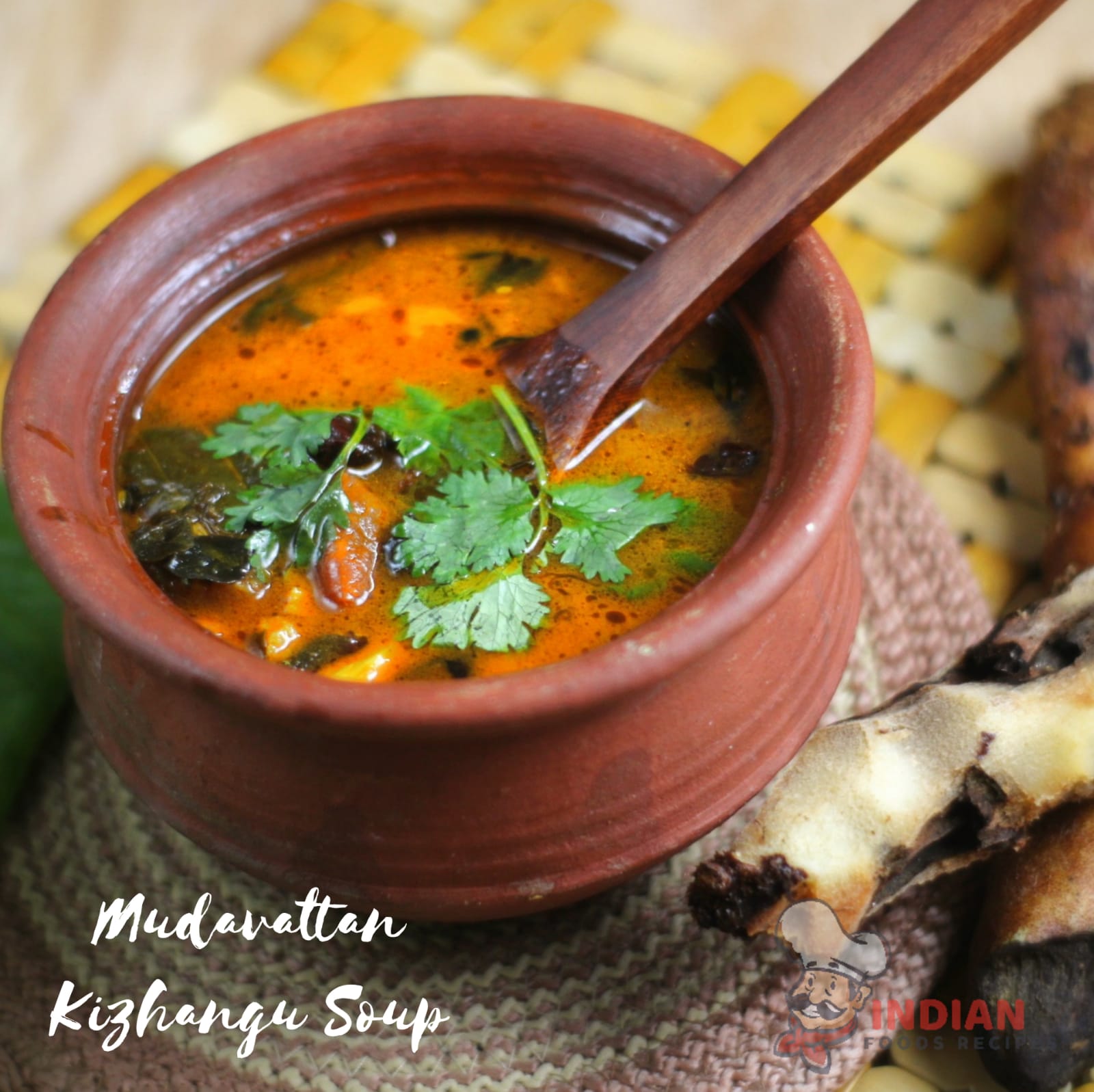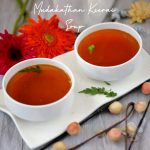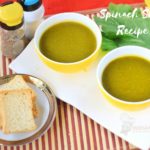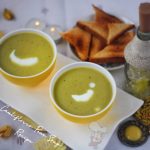An Insight Into Mudavaatukaal Kizhangu Soup Recipe:
Take a sip of this herbal concoction Mudavatukaal Kizhangu Soup that replenishes your body in an instant, gifted by Mother Nature.
A tasty vegetarian soup made of a primitive root called "Mudavattukaal Kizhangu" which grows exclusively in the hilly regions of South India. It is the miraculous substitute of aatukaal soup offered by nature with exactly the same benefits or even more.
Introduction to Mudavaatukaal Kizhangu Soup Recipe :
Mudavatukkal kizhangu Soup is one of the age old treasured traditional recipes that has been passed on to generations by our ancestors, which has been popularly used as the best remedy for arthritis and other knee related issues since several centuries. Mudavatukaal kizhangu soup is commonly prepared by the people who live around the hills as it is easily available for them and as they are much aware of its benefits too. This miraculous dish tastes astounding with the flavor of peppercorns and shallots, and has a unique flavor of its own. If you go on a visit to kolli hills or sirumalai, you can commonly see people relishing this mudavaatukaal kizhangu soup while enjoying the ethereal mist in the greenery It is an interesting sight to see people sitting in long wooden benches at petty shops, chatting about the weather, the crops that grow in the hills and the animals that frequent the areas during the nights. With a cup of tea, coffee or this mudavatukkal soup in hand, this chit chat goes endlessly till dusk. People who go on a trek to saduragiri hills and sirumalai stop by the instant stalls or the petty shops found randomly, to relish a glug of sizzling hot mudavatukkal kizhangu soup which rejuvenates them instantly to walk further.
Biological Factors Of Mudavaatukaal Kizhangu:
Its botanical name is Drynaria Quercifolia and belongs to the family Drynariaceae. It grows widely in places like kolli hills, servarayan hills, sirumalai and saduragiri. It has the appearance of sheep's legs (as the name goes) and grows up to the height of two feet length. It is brown (both dark and light) in color and has a furry outer skin like that of a goat. Much interestingly it grows only in the rocks and trees of hilly forests and not in plains. The leaves of this Kizhangu dries up and sticks on top, as a protective sheath over the root and absorbs moisture from the atmosphere and grows by itself in the hills which are approximately in the height of 4000 metres from the sea level.
Its Therapeutic Properties:
Mudavatukaal Kizhangu is loaded with astounding medicinal properties and it has been used in naatu maruthuvam since ages as a boon medicine for human beings from birth till old age. Moreover, Indian scriptures say the glory of this special mudavatukaal kizhangu and how it has been used in Siddha and Ayurveda medicine widely to cure various diseases. It helps to stabilize the three doshas of the human body kapha, pitha and vada and our ancient siddhars used this kizhangu to cure several diseases related to these doshas. They have interestingly named this kizhangu as Aagaya Rajan which means king of the sky and was much appreciated by the saint Vallalar Adigalar. It relieves knee joint pain, arthritis, pain in the ankle, calf muscle and muscle cramps too. Moreover, it also relieves neck, back and shoulder pain that occurs due to various reasons caused by stress and strain. It is one of the best post work out diet as it gives instant refreshment by rejuvenating the body cells and gives instant energy. People who suffer from prolonged knee joint pain can try out this recipe and start feeling the results in a fortnight by consuming it regularly ( for a mandalam which is 48 days). Our ancestors used to boil the Mudavatukaal kizhangu in water and pour it over the legs and massage well (for two to three months approximately) for kids who suffer from rheumatism. It also cures hip pain and a best home remedy for menstrual problem for women and treats calcium deficiency.
Here comes the simple yet delicious recipe of mudavatukaal kizhangu soup recipe which can be made in a jiffy with just a few ingredients at home.

Ingredients Required To Make Mudavaatukaal Kizhangu Soup Recipe:
How To Make Mudavaatukaal Kizhangu Soup Recipe:
Take one medium sized Mudavatukkal kizhangu and wash it thoroughly in water and scrape the fluffy outer skin with a scraper or a knife. Peel off the skin completely and chop them off into small pieces and drop it in a bowl of water.
Peel off the skin from the shallots too.
Heat an earthern Pot (mansatti) and tip in a teaspoon of sesame oil and when it is heated, just drop in a teaspoon of fennel seeds along with a roughly torn dried red chili and some curry leaves and crushed garlic.
Similarly add the measured quantities of bay leaf, anise, cloves, cinnamon and peppercorns along with a slit green chili.
When the tempering is over, just plop in the shallots into the mansatti and stir well.
After a minute or two, throw in the Mudavatukaal kizhangu pieces with a nice stir.
Sprinkle the required amount of salt along with a few pinches of turmeric powder.
Lower the flame and pop the lid on and let it remain in low flame for about fifteen minutes approximately.
When the aroma starts wafting out from the mansatti, open the lid and change the flame to high mode.
When it comes to a boil (after five minutes approximately) turn off the flame and sprinkle a lavish spread of lush green coriander leaves and turn off the flame.
Filter the soup using a colander and serve it hot in a soup bowl on a cold evening after topping it up with a dash of butter or ghee.
Tips And Tricks:
* Soak the Mudavatukaal Kizhangu in hot water for sometime as it enables easy scraping.
* It feels like chopping sugarcane and therefore the process is quite easy after peeling the skin off.
* We use shallots instead of regular onion to make such kind of traditional soups, as it gives the best taste and added health benefits.
* Similarly, soups made in earthern pots have an inexplicable deliciousness and gives an authentic feel with a deep connectivity to our ancestors. I would always suggest you to have a small set of earthern dishes (like mansatti of three different sizes at least ) if you are a lover of traditional Indian foods.
* Rock salt is yet another key ingredient which adds up to the taste and health benefits as well.
* The flavor is similar to that of Aatukaal soup and in case if you do not like the original flavor of this kizhangu you can top it up with a lavish spread of fresh coriander leaves, mint leaves, curry leaves and quarter teaspoon of butter or ghee.
* Filter the soup before serving as we just need the essence and not the pulpy mudavaattukaal kizhangu chunks. Moreover, traditional method suggests to take up just the essence and discard the solid remains.
* You can store the kizhangu for a maximum of three months at room temperature in an open basket.
* If you want, you can add a tablespoon of grated coconut and a quarter teaspoon of poppy seeds while boiling and it is quite optional.
* It gives good result if taken continuously for fifteen days and as much as possible prepare it fresh whenever needed in order to get the maximum nutrients out of it.
Ingredients
Directions
Take one medium sized Mudavatukkal kizhangu and wash it thoroughly in water and scrape the fluffy outer skin with a scraper or a knife. Peel off the skin completely and chop them off into small pieces and drop it in a bowl of water.
Peel off the skin from the shallots too.
Heat an earthern Pot (mansatti) and tip in a teaspoon of sesame oil and when it is heated, just drop in a teaspoon of fennel seeds along with a roughly torn dried red chili and some curry leaves and crushed garlic.
Similarly add the measured quantities of bay leaf, anise, cloves, cinnamon and peppercorns along with a slit green chili.
When the tempering is over, just plop in the shallots into the mansatti and stir well.
After a minute or two, throw in the Mudavatukaal kizhangu pieces with a nice stir.
Sprinkle the required amount of salt along with a few pinches of turmeric powder.
Lower the flame and pop the lid on and let it remain in low flame for about fifteen minutes approximately.
When the aroma starts wafting out from the mansatti, open the lid and change the flame to high mode.
When it comes to a boil (after five minutes approximately) turn off the flame and sprinkle a lavish spread of lush green coriander leaves and turn off the flame.
Filter the soup using a colander and serve it hot in a soup bowl on a cold evening after topping it up with a dash of butter or ghee.



